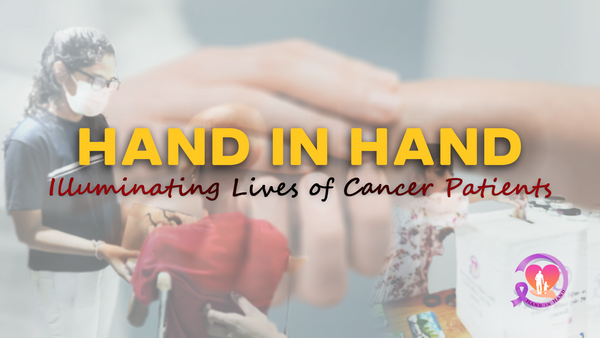Let's fight against Cancer: What causes Cancer ?
We know that cancer is a very dangerous disease, but did you know how it occurs and what causes it?
Cancer arises from the transformation of normal cells into tumour cells in a multistage process that generally progresses from a pre-cancerous lesion to a malignant tumour. These changes are the result of the interaction between a person's genetic factors and 3 categories of external carcinogens:
Genetic factors
Some types of cancers can occur in families. The risk of developing genetically caused cancer is only 5%. That is the possibility of inheriting from the mother or father. But to a large extent, this genetic variation is caused by our behavior patterns or environmental factors. Therefore if there is a change in the genes, there is a possibility that cancer may have occurred with the support of behavioral or environmental changes. A number of forces can cause gene mutations, such as smoking, radiation, viruses, cancer-causing chemicals (carcinogens), obesity, hormones, chronic inflammation and a lack of exercise.
Physical carcinogens
Physical carcinogens include ultraviolet rays from sunlight, ionizing radiation from X-rays, radioactive materials in industry and in the general environment. Other physical carcinogens that can cause cancer is electromagnetic radiation of different kinds, low and high temperatures, mechanical traumas, and gel materials.
Also, did you know that an everyday injuries are also more lethal than we thought?
That is, repeated local injury (e.g., wounding) or recurring irritation (e.g., chronic inflammation) to a part of the body can also develop into potential carcinogens.
Chemical Carcinogens
More than 400 chemical agents have been listed as carcinogenic, by the International Agency for Research on Cancer (IARC), a branch of the World Health Organization. A few well-known chemical carcinogens are Asbestos, components of tobacco smoke, aflatoxin (a food contaminant), arsenic (a drinking water contaminant) and environmental pollutants from automobiles, residences, and factories. One such example is the carcinogenic chemical acrylamide, which is produced by industrial processes and as a result of cooking certain foods at high temperatures. It is released into the environment during wastewater treatment, grout and soil stabilization products. Other examples of chemical carcinogens are nitrosamines and polycyclic aromatic hydrocarbons found in tobacco smoke. They are associated with the development of lung cancer.

A person’s risk of developing cancer depends on how much, how long, how often, and when they are exposed to these chemicals. Age counts too because a mild exposure on a fetus may be much more lethal than the same exposure to an adult.
Biological carcinogens
A number of human and animal viruses are suspected to cause cancer, often referred to as oncogenic viruses. Biological carcinogens can be identified as viruses, bacteria or parasites. Some of them are human papilloma virus, Epstein-Barr virus and hepatitis B virus, all of which have genes made up of DNA. Human T-cell leukemia virus type I (HTLV-I), retrovirus (RNA virus type) is associated with human cancer. In 2018, 810,000 Helicobacter pylori cancer patients, 690,000 human papillomavirus cancer patients and 360,000 hepatitis B virus cancer patients were reported.
Although the above-mentioned carcinogens can initiate cancer, it has now been identified that many other factors also weigh in. What is clear here is that the development of a carcinogen into a clinical disease is a multifaceted process and not an event. It happens as a series of events and a collection of mutations.
The International Agency for Research on Cancer (IARC), of World Health Organization found that, aging is another major factor in the development of cancer. It has been shown that the risk of cancer increases with age, and that the risk of developing specific cancers increases with age. As a person ages, the overall risk accumulation combines with the tendency of cell repair mechanisms to become less effective.
පිළිකාව ඉතා භයානක රෝගයක් බව අප දැන තිබුණ ද, එය හටගන්නේ කෙසේද කුමන රෝගකාරක හේතූන් නිසාද යන්න ඔබ දැන සිටියා ද ?
පිළිකාහටගන්නේ බහු අවයවික ක්රියාවලියක සාමාන්ය සෛල පිළිකා සෛල බවට පරිවර්තනය වීමෙනි. එය සාමාන්යයෙන් පිළිකා පූර්ව තුවාලයේ සිට මාරාන්තික ගෙඩියක් දක්වා වර්ධනය වේ. මෙම වෙනස්කම් ඇතිවන්නේ පුද්ගලයෙකුගේ ජානමය සාධක සහ බාහිර පිළිකා කාරක වර්ග 3 ක් අතර අන්තර් ක්රියාකාරිත්වයේ ප්රතිඵලයකිනි.
ජානමය සාධක
සමහරපිළිකා පවුල් තුළ ඇතිවිය හැකිය. ජානමය පිළිකා ඇතිවීමේ අවදානම 5% ක් පමණි. මෙමතත්වය මවගෙන් හෝ පියාගෙන් උරුම වීමේ හැකිය. නමුත් බොහෝ දුරට මෙම ජාන විචලනය සිදුවන්නේ අපගේ හැසිරීම් රටා හෝ පාරිසරික සාධක හේතුවෙනි. එබැවින් ජානවල වෙනසක් සිදුවී ඇත්නම්, චර්යාත්මක හෝ පාරිසරික වෙනස්කම් වල සහාය නොමැතිව පිළිකා ඇති නොවීමට ඉඩ තිබේ. දුම්පානය, විකිරණ, වෛරස්, පිළිකා ඇති කරන රසායනික ද්රව්ය (පිළිකා කාරක), තරබාරුකම, හෝමෝන, නිදන්ගත දැවිල්ල සහ ව්යායාම නොමැතිකම වැනි ජාන විකෘති වලට බලවේග ගණනාවක් හේතු විය හැක.
භෞතික සාධක
භෞතික පිළිකා කාරක අතරට හිරු එළියෙන් ලැබෙනපාරජම්බුල කිරණ, එක්ස් කිරණ වලින්අයනීකරණ විකිරණ, කර්මාන්තයේ සහපරිසරයේ විකිරණශීලී ද්රව්යඇතුළත් වේ. පිළිකාඇතිවිය හැකි අනෙකුත් භෞතිකපිළිකා කාරක අතරට විවිධ වර්ගවල විද්යුත් චුම්භකවිකිරණ, අඩු හා ඉහළ උෂ්ණත්වයන්, යාන්ත්රික කම්පන සහ ජෙල් ද්රව්ය ඇතුළත්වේ.
එපමණක් නොව, ඔබ දන්නවාද අපඑතරම් සැලකිලිමත් නොවන එදිනෙදා ඡීවිතයේ සිදුවන තුවාලයක්ද මෙයට හේතුකාරකයක් වියහැකි බව.
එනම්, ශරීරයේ යම් කොටසකට නැවත නැවත තුවාල ඇතිවීම (උ.දා., තුවාල වීම) හෝ පුනරාවර්තන කෝපයක් ඇතිවීම(උ.දා., නිදන්ගත දැවිල්ල) විභව භෞතික පිළිකා කාරක සඳහා හේතුන් වේ.
රසායනික සාධක
ලෝක සෞඛ්ය සංවිධානයේ ශාඛාවක්වන පිළිකා පිළිබඳ ජාත්යන්තර පර්යේෂණ ආයතනය (IARC) විසින් රසායනික කාරක 400 කට වැඩි ප්රමාණයක් පිළිකාකාරක ලෙස ලැයිස්තුගත කරඇත. එනම් ඇස්බැස්ටෝස්, දුම්කොළ දුමාරයේ සංඝටක, ඇෆ්ලාටොක්සින් (ආහාරඅපවිත්රකාරකයක්), ආසනික් (පානීය ජල අපවිත්රකාරකයක්) සහ මෝටර් රථ, වාසස්ථාන සහ කර්මාන්තශාලා වලින් සිදුවන පරිසර දූෂක රසායනික පිළිකාකාරක කිහිපයකි. උදාහරණයක් ලෙස, පිළිකා කාරකයක් ලෙස සැලකෙන ඇක්රිලමයිඩ් රසායනය, කාර්මික ක්රියාවලීන් හා ඇතැම් ආහාර අධික උෂ්ණත්වවලදී පිසීමේ ප්රතිඵලයක් ලෙස නිපද වේ. එය අපවිත්ර ජලය පවිත්රකරණය සඳහා සහ ග්රූට් සහපාංශු ස්ථායීකරණ නිෂ්පාදනසඳහා භාවිතා කිරීම මගින් පරිසරයට මුදාහරිනු ලබයි. රසායනික පිළිකා කාරක සඳහා තවත් උදාහරණ වන්නේ දුම්කොළ දුමාරයේ දක්නට ලැබෙන නයිට්රොසැමයින් සහ පොලිසයික්ලික් ඇරෝමැටික හයිඩ්රොකාබන්ය. ඒවා පෙනහළු පිළිකා වර්ධනය සමඟ සම්බන්ධ වේ.
පුද්ගලයෙකුගේ පිළිකා වැළඳීමේ අවදානම රඳා පවතින්නේ මෙම රසායනික ද්රව්යවලට කොපමණ ප්රමාණයක්, කොපමණ කාලයක් සහ කොපමණ වාර ගණනක් නිරාවරණය වන්නේද යන්න මතය. නිදසුනක් වශයෙන්, ගර්භාෂයේ කුඩා නිරාවරණයක් වැඩිහිටියෙකු ලෙස කුඩා නිරාවරණයකට වඩා බරපතළ විය හැකි බැවින් යමෙකු නිරාවරණය වන විට එය වැදගත් බව සලකන්න. එසේම, ඔබේ දෙමව්පියන්ගෙන් ඔබට උරුම වන ජාන ද එයට හේතු වේ.
ඡීව විද්යාත්මකසාධක
මිනිසුන්ගේ සහ සතුන්ගේ වෛරස් ගණනාවක් පිළිකාවන් ඇති වීමට සැක කෙරෙන අතර ඒවා බොහෝ විට ඔන්කෝජනික් වෛරස ලෙස හැඳින්වේ. ජීව පිළිකා කාරක ලෙස වෛරස්, බැක්ටීරියා හෝ පරපෝෂිතයන් හදුනා ගත හැක. ඒවායින් සමහරක් මානව පැපිලෝමා වයිරස්, එප්ස්ටයින්-බාර් වෛරසය සහ හෙපටයිටිස් බී වෛරසය වන අතර ඒ සියල්ලටම DNA වලින් සෑදී ඇති ජාන ඇත. මානව T-සෛල ලියුකේමියා වෛරස් වර්ගය I (HTLV-I), රෙට්රො වයිරස් (ආර්එන්ඒ වෛරස් වර්ගයක්) පිළිකා සමඟ සම්බන්ධ වේ. හෙලිකොබැක්ටර් ප්ලියෝරි පිළිකා රෝගීන් 810,000 ක්, හියුමන් පැපිලෝමා වෛරස පිළිකා රෝගීන් 690,000 ක් සහ හෙපටයිටිස් බී වෛරස් පිළිකා රෝගීන් 360,000 ක් 2018 දී පිළිකා ආසාදන වාර්තා විය.
පිළිකාවක් ආරම්භවීමට ඉහත සඳහන් පිළිකාකාරක හේතුන්ද තාක්ෂණික සහ විද්යාවේ දියුණුව සමග එය එතරම් සරල නොවන බව හදුනා ගෙන ඇත. වර්තමානය වන විට වැඩිහිටි ශරීරය සෑම අවයවයකම මාරාන්තික පිළිකා සෛල සොයාගෙන ඇත. මෙහිදී පැහැදිලි ලෙස පෙනෙන දෙය නම්, පිළිකා කාරකයක් සායනික රෝගයක් බවට වර්ධනය වීම බහුවිධ ක්රියාවලියක් මිස සිදුවීමක් නොවන බවයි. එය සිදුවීම් මාලාවක් සහ විකෘති සමුච්චයක් ලෙස සිදු වේ.
ලෝක සෞඛ්ය සංවිධානය සිය පිළිකා පිළිබඳ ජාත්යන්තර පර්යේෂණ ආයතනය (IARC) හරහා සොයා ගන්නා ලද කරුණක් නම්,
වයසට යාම පිළිකා වර්ධනය සඳහා තවත් මූලික සාධකයකි. වයස්ගත වීමත් සමඟ පිළිකා ඇතිවීමේ ප්රවණතාව ඉහළ යන බවත්, බොහෝ විට වයස්ගත වීමත් සමඟ විශේෂිත පිළිකා සඳහා අවදානම් ගොඩනැගීම හැකි බවත්ය. පුද්ගලයෙකු වයස්ගත වන විට සෛල අළුත්වැඩියා කිරීමේ යාන්ත්රණයන් අඩු ඵලදායී වීමට ඇති ප්රවණතාව සමඟ සමස්ත අවදානම් සමුච්චය සංයුක්ත වේ.
Check out our other blogs on cancer;
1) What is cancer: https://blog.rotaractmora.org/what-is-cancer/
2) What causes cancer: http://blog.rotaractmora.org/causes-of-cancer/
3) Childhood cancer: http://blog.rotaractmora.org/fight-against-cancer/
4) Leukemia: https://blog.rotaractmora.org/hih-cancer-leukemia/
5) Brain cancer: https://blog.rotaractmora.org/brain-cancer/
6) Lung cancer: https://blog.rotaractmora.org/lung-cancer/
7) Breast cancer: https://blog.rotaractmora.org/breast-cancer/
8) Skin cancer: http://blog.rotaractmora.org/skin-cancer/
9) Oral cancer: https://blog.rotaractmora.org/oral-cancer/
10) Thyroid cancer: https://blog.rotaractmora.org/thyroid-cancer-2/
11) Movie review- The fault in our stars: https://blog.rotaractmora.org/movie-review-the-fault-in-our-stars/
12) Cervical cancer: http://blog.rotaractmora.org/cervical-cancer/
13) Colorectal cancer: http://blog.rotaractmora.org/colorectal-cancer/
14) Movie review: My life without me: http://blog.rotaractmora.org/moviereviewmylifewithoutme/
15) Cancer health policy of WHO: http://blog.rotaractmora.org/health-policy-of-who/



